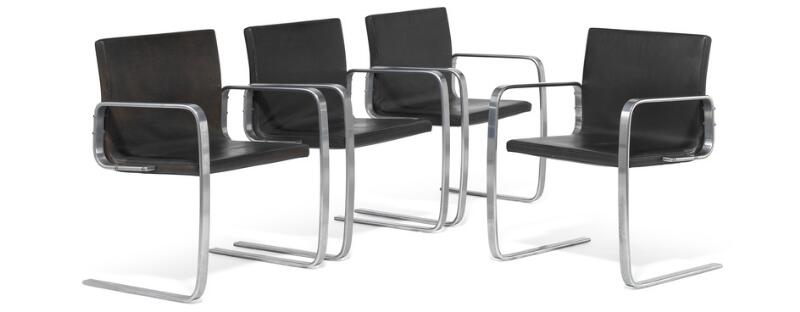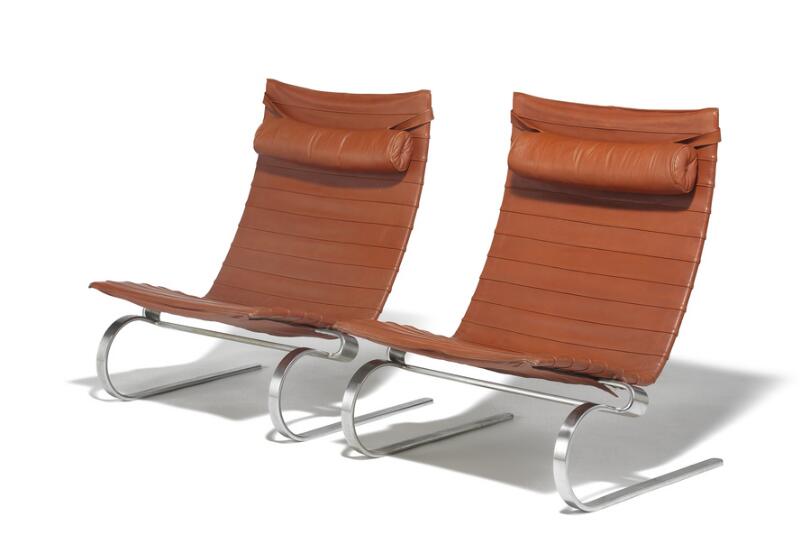“PK 25”. A pair of early and rare chairs with hand forged frames of matte chromed steel. Seat and back with flag halyard. Designed 1951. These examples made 1952 by Fritz Hansen (2) Provenance: Halldor Gunnløgsson. Literature: ed. Christoffer Harlang a.o “Poul Kjærholm”,Arkitektens Forlag, 1999, actual chairs depicted p. 150–151. Literature: Michael Sheridan “Poul Kjærholm Møbelarkitekt”, Louisiana 2006, actual chairs depicted p. 25. The PK 25 chair was one of Poul Kjærholm's very first furniture pieces. But perhaps was also his greatest masterpiece. Which is even more impressive since it was actually a final assignment during his education. In 1949, Poul Kjærholm was enrolled in the Furniture Department at the Danish School of Arts and Crafts in Copenhagen after being trained as a cabinetmaker in Hjørring. In Copenhagen, he became a student of Hans J. Wegner, who could see both a genuine talent in his student and perhaps also a little of himself in the young ambitious cabinetmaker from Jutland who had come to Copenhagen. Poul Kjærholm was employed part-time in Wegner's studio and was greatly influenced by Wegner during the fruitful period around 1950. At the Danish School of Arts and Crafts, Wegner presented his students with a final assignment in 1951, where they had to design furniture for a well-known architect's living room, and from the models build one finished piece of furniture. For Poul Kjærholm the task fell on architect Halldor Gunnløgsson's living room. It was the start of a friendship and professional collaboration that would last throughout the years. There were several of these furniture models that pointed in the directions that Kjærholm would later follow in his design, but it was the chair he chose as his final project that would become his breakthrough as a furniture architect and turned out to be one of the most important furniture pieces in the history of Danish design. With his “PK 25” chair, Poul Kjærholm drew on inspiration from the comparable flag halyard chair that his teacher Hans J. Wegner had drawn in 1950 and made of the same materials - steel and flag halyard. The clear separation between the carrying element - the steel - and the carried element - the flag halyard - made the chair clear and easy to read, which became one of Kjærholm's trademarks. However, it is the innovative and almost carpentry approach to the steel as a material that elevates the “PK 25” chair and Poul Kjærholm's furniture in general to a league of its own. With “PK 25”, a steel frame chair is created entirely without the use of joints or welding and transforms the steel from something cold and industrial to craftsmanship without losing the tight shape. The idea of creating a chair through the use of folds and slits is known from others - one possible inspiration seems to be British Gerald Summers' famous plywood chair from 1934 for Makers of Simple Furniture, itself an early modernist masterpiece albeit with a softer organic form. However, Kjærholm's genius consists of taking steel, which most people associate with something hard and rigid, and then bending it as if it were a paper airplane. When the chair was seen by Fritz Hansen's Managing Director Søren Hansen it led to Poul Kjærholm being hired by Fritz Hansen where Kjærholm focused on further experiments with materials. Here, the “PK 25” chair was put in a very limited production in 1952, where the first three production models, from which this pair of chairs originate, ended up with the architect they were intended for all along, i.e. Halldor Gunnløgsson. Kjærholm left Fritz Hansen shortly thereafter. And in 1955 began the legendary collaboration with E. Kold Christensen, who took over the production of the “PK25” chair, with his other designs. In 1982 after Kjærholm’s premature death, the rights to most Kjærholm models went to Fritz Hansen - including the “PK25” model. This is a fun reminder of the saying ‘no rules without exceptions’ since
Condition report on request. Please contact: design@bruun-rasmussen.dk
“PK 25”. A pair of early and rare chairs with hand forged frames of matte chromed steel. Seat and back with flag halyard. Designed 1951. These examples made 1952 by Fritz Hansen (2) Provenance: Halldor Gunnløgsson. Literature: ed. Christoffer Harlang a.o “Poul Kjærholm”,Arkitektens Forlag, 1999, actual chairs depicted p. 150–151. Literature: Michael Sheridan “Poul Kjærholm Møbelarkitekt”, Louisiana 2006, actual chairs depicted p. 25. The PK 25 chair was one of Poul Kjærholm's very first furniture pieces. But perhaps was also his greatest masterpiece. Which is even more impressive since it was actually a final assignment during his education. In 1949, Poul Kjærholm was enrolled in the Furniture Department at the Danish School of Arts and Crafts in Copenhagen after being trained as a cabinetmaker in Hjørring. In Copenhagen, he became a student of Hans J. Wegner, who could see both a genuine talent in his student and perhaps also a little of himself in the young ambitious cabinetmaker from Jutland who had come to Copenhagen. Poul Kjærholm was employed part-time in Wegner's studio and was greatly influenced by Wegner during the fruitful period around 1950. At the Danish School of Arts and Crafts, Wegner presented his students with a final assignment in 1951, where they had to design furniture for a well-known architect's living room, and from the models build one finished piece of furniture. For Poul Kjærholm the task fell on architect Halldor Gunnløgsson's living room. It was the start of a friendship and professional collaboration that would last throughout the years. There were several of these furniture models that pointed in the directions that Kjærholm would later follow in his design, but it was the chair he chose as his final project that would become his breakthrough as a furniture architect and turned out to be one of the most important furniture pieces in the history of Danish design. With his “PK 25” chair, Poul Kjærholm drew on inspiration from the comparable flag halyard chair that his teacher Hans J. Wegner had drawn in 1950 and made of the same materials - steel and flag halyard. The clear separation between the carrying element - the steel - and the carried element - the flag halyard - made the chair clear and easy to read, which became one of Kjærholm's trademarks. However, it is the innovative and almost carpentry approach to the steel as a material that elevates the “PK 25” chair and Poul Kjærholm's furniture in general to a league of its own. With “PK 25”, a steel frame chair is created entirely without the use of joints or welding and transforms the steel from something cold and industrial to craftsmanship without losing the tight shape. The idea of creating a chair through the use of folds and slits is known from others - one possible inspiration seems to be British Gerald Summers' famous plywood chair from 1934 for Makers of Simple Furniture, itself an early modernist masterpiece albeit with a softer organic form. However, Kjærholm's genius consists of taking steel, which most people associate with something hard and rigid, and then bending it as if it were a paper airplane. When the chair was seen by Fritz Hansen's Managing Director Søren Hansen it led to Poul Kjærholm being hired by Fritz Hansen where Kjærholm focused on further experiments with materials. Here, the “PK 25” chair was put in a very limited production in 1952, where the first three production models, from which this pair of chairs originate, ended up with the architect they were intended for all along, i.e. Halldor Gunnløgsson. Kjærholm left Fritz Hansen shortly thereafter. And in 1955 began the legendary collaboration with E. Kold Christensen, who took over the production of the “PK25” chair, with his other designs. In 1982 after Kjærholm’s premature death, the rights to most Kjærholm models went to Fritz Hansen - including the “PK25” model. This is a fun reminder of the saying ‘no rules without exceptions’ since
Condition report on request. Please contact: design@bruun-rasmussen.dk














Try LotSearch and its premium features for 7 days - without any costs!
Be notified automatically about new items in upcoming auctions.
Create an alert